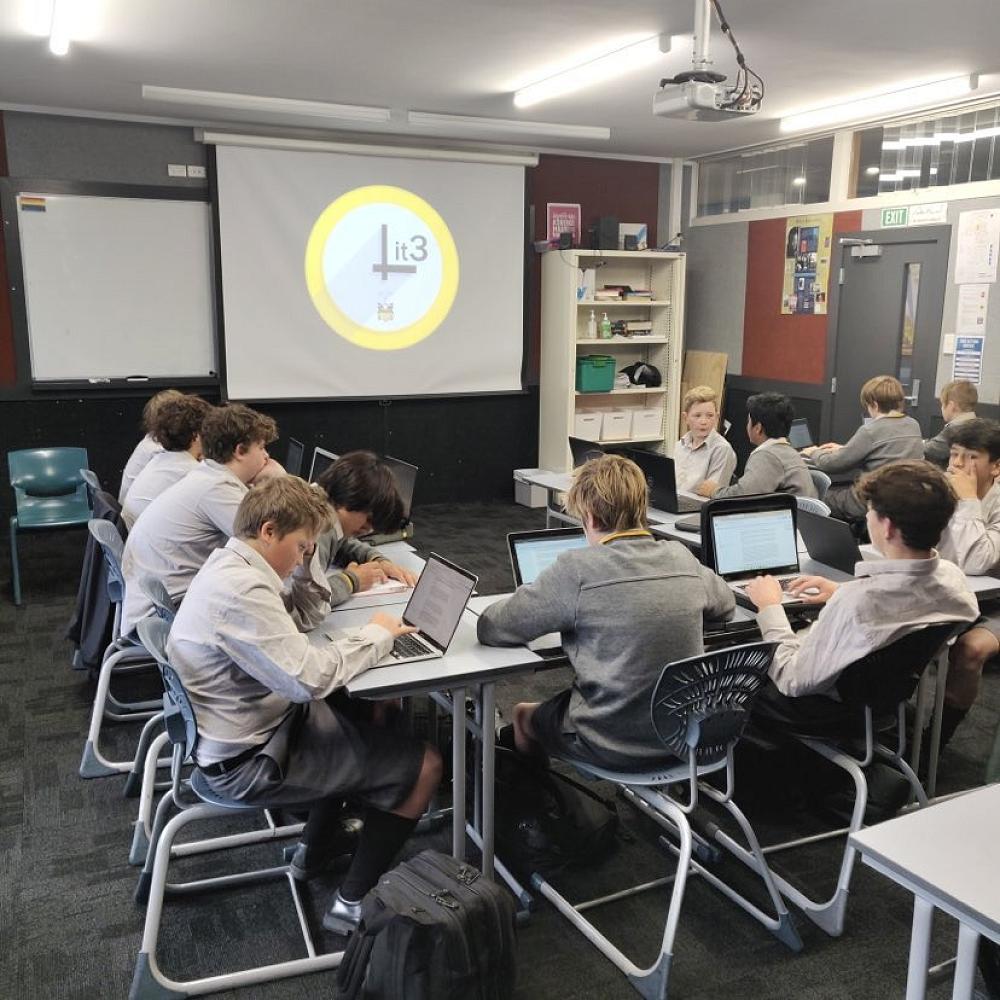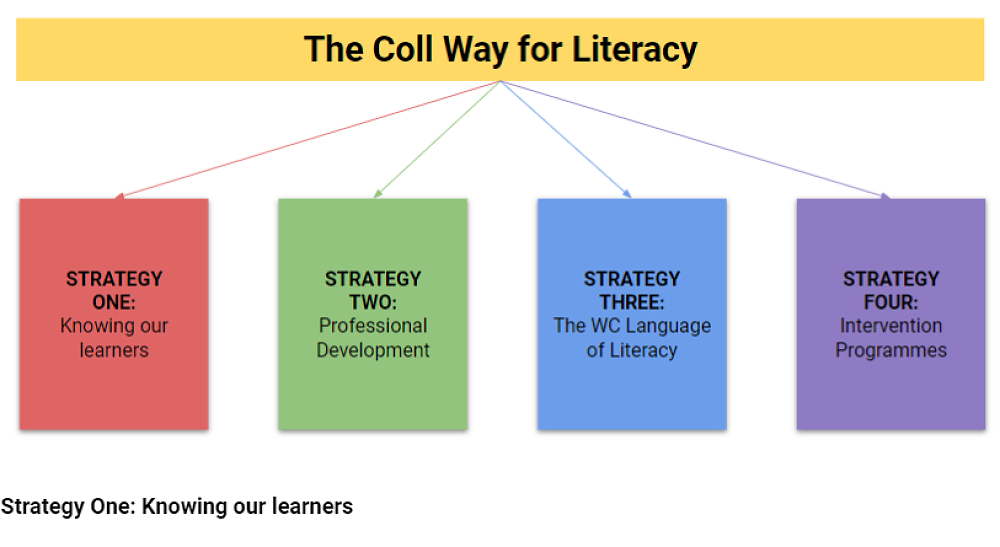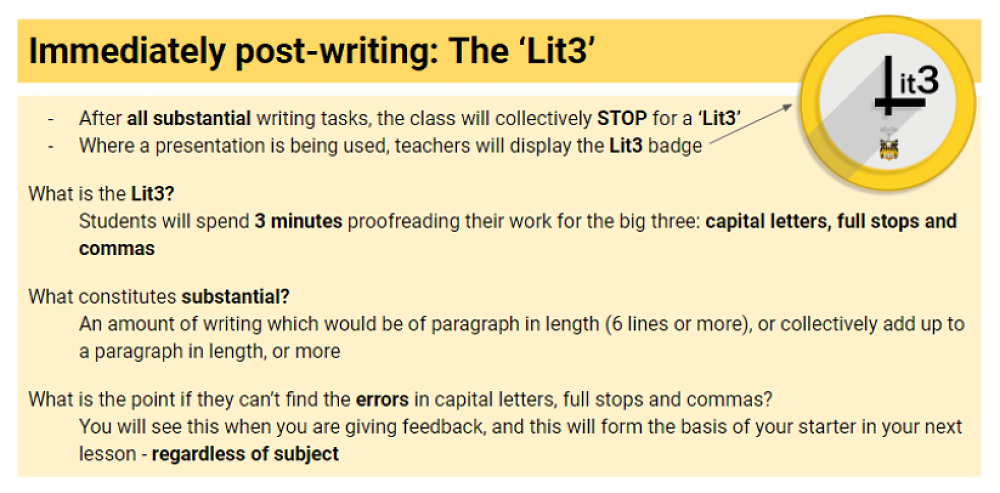
Literacy: It’s just the ability to read and write, right?
Earlier this year, the Education Hub noted that just 35% of Year 8s are achieving at or above their expected curriculum level for writing. In this new blog piece, Assistant Principal Serena Lawrence outlines our journey with our new Wellington College literacy strategy in response to this concerning national trend.
The Oxford English Dictionary defines literacy as simply ‘the ability to read and write’, and functional literacy as ‘the ability to read and write at the level required to perform everyday tasks’.
Now, it might be uncomfortable to admit, but I think we have, as secondary school teachers, expect that our young people come to us with literacy, certainly functional literacy, skills already in place. Therefore, we have believed that teaching functional literacy was not our problem. Yet more so than ever we are faced with the reality that this is not the case, with the Education Hub noting in 2023 that just 35% of Year 8’s are achieving at or above their expected curriculum level for writing. When faced with a problem as large as this, it can sometimes feel easier to search for a place to put the blame rather than starting the daunting journey of undoing the damage. Unfortunately for us, there is no one ‘error’, instead, the perfect storm of conditions over time that have led to the position our young people are in. And so, it is time to move forward, one step at a time.
So what was this first step going to look like at Wellington College? Well, having read all of the reports on declining literacy and looked at the pass rates for the pilot of the co-requisites, it was fair to say I was feeling a sense of overwhelm. It was time to take a step back. I thought to myself: ‘if you were working with a teacher who was struggling with the underachievement of a student in their class, what would your advice be to them?’. Then it became clear:
Start by finding out exactly where the student was at in their journey
Make sure we clearly understood where they were trying to get to
Work out all of the steps in learning that needed to happen between where they’re at and where they needed to get to
Start with the first step, check progress, move on to the next step when they were ready
The follow up thought: What would we then expect that teacher to be able to show by the next time we met? That the student in question had suddenly met all of their learning goals and was hitting their targets? No, of course not. But we would expect to see incremental gains based on the clear actions that had been put in place. With this, the ‘Coll Way for Literacy’ was born.

Strategy One: Knowing our learners
The first step here was to research what other schools had been doing across the pilot to establish readiness for the co-requisites. In doing so, we came across the exceptional work of Jake Wills at Kāpiti College, who had compared PAT data with co-requisite pilot results. This gave us a place to start our analysis. Using this we were able to look at our own data and established the wide gap between where our Year 9 and 10 cohorts were at and where they needed to get to. We ensured that this data was available for staff on the individual learners in their classes, and that they understood what it meant. We have then continued to check in on this data as we move closer to our first round of co-requisites. Already this data is showing us that a much larger portion of our Year 10s are ready to sit their co-requisites than seven months ago.
So, now we knew where our young people were at, but did we truly understand where we needed them to get to?
Strategy Two: Professional Development
If there is one thing NCEA has drilled into teachers, it's the importance of knowing the specifications of an assessment before we begin teaching it. Every little detail. And whilst the importance of ensuring our young people have better than functional literacy is far greater than the importance of one exam, we also can’t shy away from the reality that in order to achieve any of their qualifications, those same young people must pass an exam. Therefore, professional development had to come in a few forms. Including, but not limited to:
Developing all teachers understanding of the specifications of the co-requisites
Developing all teachers pedagogical capacity to teach students to read and write accurately
But also one that was the metaphorical ‘comma in the room’. Before a teacher can teach students to read and write accurately, they must be able to do so themselves. And before anyone reading this feels ‘shocked’ that a teacher might not always be able to use a comma in the right place, we must face the reality. That being: many of us were educated in a system which did not teach us the nuts and bolts of using a comma, and therefore we do not have the language to explain the mechanics of a sentence - let alone to identify why one is inaccurate once we have pointed out that it isn’t right. If we truly want all teachers to be teachers of literacy, then we have identified another crucial area of professional development: developing all teachers' understanding of the mechanics of reading and writing.
However, whilst we were busy ensuring our teachers knew everything they needed to know to help our young people, we also needed to ensure the literacy development of our young people continued. This brings us back to that third thing I would suggest to a teacher: what are all the steps between where our students are at and where they need to be? Take it one step at a time.
Strategy Three: The WC Language of Literacy
The list of things our students needed to know, understand and crucially, do, felt immense. But there was one that stood out. A perennial problem that was sung down the corridors of schools across the globe: “WHY won’t our students use capital letters when they are meant to? They know the rules!”. As an English teacher I had joined in with the choir, having corrected thousands of pieces of work with little red circles around words needing a capital letter, muttering with frustration to myself about my students not proofreading properly. The problem wasn’t entirely my students' inability to proofread, but also teachers not supporting students to automate the process of capitalisation. In the same way we work hard to automate other processes such as using a topic sentence at the beginning of a paragraph or being silent while someone is talking. We reinforce these ‘rules’ over and over, across each subject and each period of a day, but with capital letters we just expect our students to know how to use them because they were once taught the rules, and then shake our heads when they don’t.
And so came the lightbulb moment. We need to support our students in automating the process of proofreading. How do we do that? The same way we learnt to tie our shoes and all other skills we now use as adults without even thinking. Repetition to create the automated pathway in our brains. I don’t have to pause to place a capital ‘S’ at the beginning of my name because my brain has automated the process after thousands of repetitions. But I didn’t always know how to do this, I was told to do this and then corrected time and again. I know many might respond to this with ‘Yeah, I just did it, why can’t they?’. Well because it was far easier ‘back then’, we only wrote with a pen/pencil and paper and really only at school or where an adult was going to read it and have the ability to correct us. That isn’t the world we live in today. Our young people are writing inaccurately through their devices all day, every day, without correction, and so the inaccuracy is the pathway being established. We need to be the loudest voice.
This brings us to: The Lit3. Students being overtly told to stop and correct their capital letters, full stops and commas at the end of each writing task. The success of creating this automation will come from the support of every staff member - without this, we don’t have the repetition required to create the automated pathway and become the ‘loudest voice’, and so the lack of capital letters will continue.

We also introduced another strategy called Top10 marking at the same time, where teachers mark the first 10 literacy errors in the margins of student work using literacy codes, but in doing so went against one of my own pieces of advice: Start with one piece of learning, make sure that is successful, then move on to the next. And so, whilst the Top10 marking is extremely valuable and where teachers are using this it is having great success in improving literacy outcomes, the work to embed it across the school is on ‘pause’ until we have really nailed the use of the Lit3. Improving literacy outcomes in a way which is sustainable and improves outcomes for all learners is a marathon, not a 100m sprint.
Whilst one size fits all approaches like the Lit3 are great for the majority of our students, what about the ones whose list of things they need to work on is so much greater than the rest?
Strategy Four: Intervention Programmes
At this point in the development of ‘The Coll Way for Literacy’ it became clear that we needed to further develop our provision for students with much lower literacy levels if they were to make the accelerated progress needed to be successful. This has already begun with the extension of our Integrated Studies programme into senior levels, along with the amazing work that Caitlin Pollock has done with her team in rewriting the junior Integrated Studies curriculum to support this accelerated progress.
However, what the data is telling us is that this is catering to small a number, and we need to go further. To help us work out what ‘further’ looks like at Wellington College, we have been fortunate enough to spend time with Jamie Casley at Hutt Valley High School, as well as Jake and his team at Kāpiti College who both have embedded literacy programmes running already. It has been invaluable to hear what these schools are doing, and to hear about how they are continuing to refine and adapt as the needs of young people in New Zealand continue to evolve. Out of this learning the Year 10 Literacy programme for 2024 has been born, which will sit alongside the Integrated Studies classes.
So, ten months on from the launch of ‘The Coll Way for Literacy’, where are we at? Well, we are definitely still running that marathon and will be for some time yet, if not always. I have been reminded that if we are to create true change in literacy outcomes, that the same rules I apply to learning with my students must be applied to learners of all ages:
One thing at a time. There are so many things in the pipeline for ‘The Coll Way for Literacy’ but if we are going to do this right, we must have patience.
Repetition repetition repetition: we must be the broken record. We haven’t said it enough until we get the ‘oh this again’ with the roll of the eyes.
Listen to feedback and then try again, but don’t give up. It’s too important. If not us, then who?
On that, I leave you with this thought from the great Dr Seuss: “The more that you read, the more things you will know. The more you learn, the more places you’ll go.” I want our young people to go to all of the places in their dreams, and I don’t want a lack of literacy to be the thing that stops them getting there. So we keep improving: One step at a time.
Further resources:
